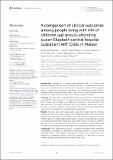Files in this item
A comparison of clinical outcomes among people living with HIV of different age groups attending Queen Elizabeth Central Hospital Outpatient ART Clinic in Malawi
Item metadata
| dc.contributor.author | Chakakala-Chaziya, Jessica | |
| dc.contributor.author | Patson, Noel | |
| dc.contributor.author | Samuel, Vincent | |
| dc.contributor.author | Mbotwa, John | |
| dc.contributor.author | Buonsenso, Danilo | |
| dc.contributor.author | Chisale, Master | |
| dc.contributor.author | Phiri, Eddie | |
| dc.contributor.author | O'Hare, Bernadette Ann-Marie | |
| dc.date.accessioned | 2023-09-20T08:30:06Z | |
| dc.date.available | 2023-09-20T08:30:06Z | |
| dc.date.issued | 2023-09-19 | |
| dc.identifier | 293954371 | |
| dc.identifier | 238f46eb-156f-44ca-af60-dc4f8f972b8b | |
| dc.identifier | 85173565330 | |
| dc.identifier.citation | Chakakala-Chaziya , J , Patson , N , Samuel , V , Mbotwa , J , Buonsenso , D , Chisale , M , Phiri , E & O'Hare , B A-M 2023 , ' A comparison of clinical outcomes among people living with HIV of different age groups attending Queen Elizabeth Central Hospital Outpatient ART Clinic in Malawi ' , Frontiers in Medicine , vol. 10 , 1175553 . https://doi.org/10.3389/fmed.2023.1175553 | en |
| dc.identifier.issn | 2296-858X | |
| dc.identifier.other | ORCID: /0000-0003-1730-7941/work/142904660 | |
| dc.identifier.uri | https://hdl.handle.net/10023/28427 | |
| dc.description.abstract | Introduction: Adherence to Antiretroviral Treatment (ART) in children and adolescents living with HIV in low-resource settings is not extensively studied in large cohort studies including both adults and pediatric patients. We compared rates of virological suppression, adherence and defaulting among children, adolescents and adults attending a family ART clinic at Queen Elizabeth Central Hospital; a tertiary hospital situated in the southern region of Malawi. Methods: The study was longitudinal and made use of routinely collected data for all 27,229 clinic attendees. Clinical information obtained at routine clinical visits entered electronically since 2008 was extracted in February 2017. This data was used to ascertain differences across the different age groups. Logistic regression and Cox regression models were fitted to compare rates of Virological Suppression (VS), adherence, and defaulting, respectively. Results: Younger and older adolescents (ages 10–14 years and 15–19 years respectively) were less likely to achieve VS compared to adults in the final model AOR 0.4 (0.2–0.9, 95% CI) and AOR 0.2 (0.1–0.4, 95% CI) respectively. Young children (ages 0–4 years), older children (ages 5–9 years) and younger adolescents were less adherent to ART compared to adults AOR 0.1 (0.1–0.2, 95% CI), AOR 0.2 (0.1–0.3, 95% CI), and AOR 0.4 (0.3–0.5, 95% CI) respectively. Young adults and younger children had an increased likelihood of defaulting compared to adults. Conclusion: Poor performance on ART of children and adolescents highlights unaddressed challenges to adherence. Ongoing research to explore these potential barriers and possible interventions needs to be carried out. The adherence assessment methods used and strategies for improving it among children and adolescents need to be revised at the clinic. | |
| dc.format.extent | 8 | |
| dc.format.extent | 594049 | |
| dc.language.iso | eng | |
| dc.relation.ispartof | Frontiers in Medicine | en |
| dc.subject | RR-NDAS | en |
| dc.subject | SDG 3 - Good Health and Well-being | en |
| dc.title | A comparison of clinical outcomes among people living with HIV of different age groups attending Queen Elizabeth Central Hospital Outpatient ART Clinic in Malawi | en |
| dc.type | Journal article | en |
| dc.contributor.institution | University of St Andrews. Population and Behavioural Science Division | en |
| dc.contributor.institution | University of St Andrews. Infection and Global Health Division | en |
| dc.contributor.institution | University of St Andrews. School of Medicine | en |
| dc.identifier.doi | https://doi.org/10.3389/fmed.2023.1175553 | |
| dc.description.status | Peer reviewed | en |
This item appears in the following Collection(s)
Items in the St Andrews Research Repository are protected by copyright, with all rights reserved, unless otherwise indicated.

